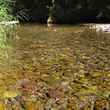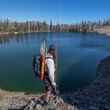Grayling, once abundant throughout much of Michigan and Montana, are now virtually extinct from their natural range in the lower 48. Grayling once populated rivers on both the upper and lower peninsula in Michigan, and were historically found in the Sun River, Smith River, Gallatin River, Madison River, Red Rock-Beaverhead-Jefferson Rivers, and Big Hole River in Montana. Today, fluvial (river dewlling) grayling are now completely extirpated from their former range in Michican and exist only in the Big Hole River drainage in Montana, although their non-fluvial, lacustrine bretheren have been artificially introduced into many high elevation lakes in the contiguous United States. Though numerous factors have contributed to the grayling's demise, declining water quality throughout the rivers and streams of the grayling's normal range is considered primarily to blame.
Grayling, which are their own subfamily of the salmon family (not part of the whitefish subfamily, as they are commonly thought to be) and a distant relative of trout, are incredibly sensitive to changes in water quality. Grayling require swift-flowing, clean, well-oxygenated cold water rivers and streams which are typically lined with sandy or gravely bottoms. Due to their sensitivity to water quality, grayling are often considered indicator species. In waters where grayling have previously or continue to persist, declining grayling populations are closely correlated with and often signal the existence of water quality issues.
Water quality issues are invariably the result of habitat degradation throughout the grayling's former range. In Montana, these water quality declines are often the result of factors such as the adjacency or near proximity of agricultural lands and roads as well as energy development. According to an environmental assessment produced by the US Fish and Wildlife Service and the Montana Department of Fish, Wildlife and Parks, "historical and contemporary land use in the Big Hole Valley has led to habitat degradation, fragmentation, and loss. Specifically, irrigation diversions have reduced streamflows and may block migratory pathways, and uncontrolled livestock grazing has severely impacted streamside (riparian) habitats. Collectively, these circumstances have led to stream dewatering, elevated summer water temperatures, channel alterations and habitat simplification, and the reduced the ability of fluvial Arctic grayling to access necessary habitats."

In response to these findings, Montana imposed regulations incentivizing landowners in an area of 380,000 acres in the Big Hole River watershed to take actions which would improve streamflows, improve and protect the function of riparian habitats, identify and reduce or eliminate grayling entrainment threats (i.e. irrigation ditches) and remove artificial barriers to grayling migration.
In many areas throughout Canada and in Alaska, where cold clean waters that have seen little impact from human development remain, Arctic grayling are still abundant in their natural range. These populations, genetically distinct from their brethren in the lower 48 since they were separated during the glacial period, remain vibrant and produce larger and longer living grayling when compared to the remaining native and introduced populations in the contiguous United States.

During a recent visit to Wood Tikchik State Park in Alaska's Bristol Bay region, we traveled significant distances and spent entire days pursuing world class grayling, some which approached 24 inches long. For those who have never chased grayling with a fly rod, they are a magnificent species to behold. As non-selective feeders, grayling rise readily to dry flies, often turning downstream to follow and take a pattern floated overhead. Although not known for long runs and prolonged battles, grayling provide an entertaining fight on a 4 weight and larger specimens will put a stout bend in a 5 weight. Aesthetically, they are an elegant fish with an amazing, colorful fins, including a spectacular dorsal fin which they raise and lower like a sail.
Even during the times when the grayling were a distraction, their voracious feeding habits often getting in the way of our pursuit of large Agulupak River rainbows with tiny dry flies, it was hard not to marvel at each specimen that found its way to the net, and difficult not to be reminded of the cold, clean water that the grayling's presence signaled.

































Comments
kyle replied on Permalink
Just one more natural resource we've rid ourselves of by placing mega-corporate energy and agriculture business (not mom and pop farms) ahead of our country's natural legacy.
The American way.
Richard Raisler replied on Permalink
The article needs to include the construction of an earthen dam that created Lima Reservoir. The first dam on the Missouri River watershed. Also, Clark Canyon Dam.
Pages